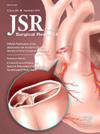预防性萨尔托里肌瓣重建可减少血管移植物感染。
IF 1.8
3区 医学
Q2 SURGERY
引用次数: 0
摘要
导言:血管手术后股骨部位经常出现并发症,发病率相当高,包括潜在的移植物感染风险。萨尔图里斯肌瓣是治疗伤口并发症的重要辅助手段。在这项研究中,我们考察了预防性萨尔图里斯肌皮瓣覆盖的经验及其与人工血管移植感染的关系:在这项单中心分析中,我们对 2012 年至 2021 年期间进行的所有artorius肌皮瓣手术的电子病历进行了回顾性审查。预防性适应症的定义是:在没有活动性腹股沟感染的情况下,在指数血管重建过程中进行皮瓣重建:在9年期间,共有47名患者接受了54例预防性腓肠肌肌皮瓣手术。患者年龄中位数为 66 岁(四分位数间距 [IQR] 61-77 岁)。16例(29.6%)患者出现了需要再次手术的伤口并发症,包括6例(11.1%)手术部位感染、5例(9.3%)伤口开裂和5例(9.3%)血清块感染。在出现伤口并发症的患者中,30 天后再入院率(75.0% 对 26.3%,P = 0.004)和再次手术制作皮瓣率(25.0% 对 2.6%,P = 0.010)较高,而 30 天后死亡率(0.0% 对 5.3%,P = 0.51)则相似。中位随访期为2.4年(IQR 0.9-4.0年),仅有一名患者(1.9%)发生血管移植感染。多变量分析显示,体重指数(调整后的几率比1.23,95%置信区间为1.12-1.35,P = 0.023)与再手术伤口并发症有关:结论:在这一高风险人群中,预防性腓肠肌瓣制作术后伤口并发症很常见,但下层血管移植物感染却很少见。这些数据表明,腓肠肌瓣在预防性治疗中可能是有效的。本文章由计算机程序翻译,如有差异,请以英文原文为准。
Prophylactic Sartorius Flap Reconstruction is Associated With Reduced Vascular Graft Infection
Introduction
Complications in the femoral area following vascular surgery are frequent and linked to considerable morbidity, including the risk of underlying graft infection. Sartorius muscle flaps are an important adjunct for the treatment of wound complications. In this study, we examined our experience with prophylactic sartorius muscle flap coverage and its association with prosthetic vascular graft infection.
Methods
In this single-center analysis, electronic medical records were retrospectively reviewed for all sartorius muscle flap procedures performed from 2012 to 2021. Prophylactic indication was defined as flap reconstruction during index revascularization in the absence of active inguinal infection.
Results
Over the 9-y period, a total of 54 prophylactic sartorius flaps were performed in 47 patients. The median patient age was 66 y (interquartile range [IQR] 61-77 y). Wound complications requiring reintervention occurred in 16 (29.6%) patients, including 6 (11.1%) surgical site infections, 5 (9.3%) wound dehiscence, and 5 (9.3%) infected seromata. Among patients suffering wound complications, 30-d readmission (75.0% versus 26.3%, P = 0.004) and reoperative flap creation rates (25.0% versus 2.6%, P = 0.010) were higher, whereas 30-d mortality rates (0.0% versus 5.3%, P = 0.51) were similar. Only one patient (1.9%) developed vascular graft infection over a median follow-up period of 2.4 y (IQR 0.9-4.0 y). On multivariate analysis, body mass index (adjusted odds ratio 1.23, 95% confidence interval, 1.12-1.35, P = 0.023) was associated with reoperative wound complications.
Conclusions
Wound complications were common after prophylactic sartorius flap creation in this high-risk population; however, infection of the underlying vascular graft was rare. These data suggest that sartorius flap may be effective in a prophylactic role.
求助全文
通过发布文献求助,成功后即可免费获取论文全文。
去求助
来源期刊
CiteScore
3.90
自引率
4.50%
发文量
627
审稿时长
138 days
期刊介绍:
The Journal of Surgical Research: Clinical and Laboratory Investigation publishes original articles concerned with clinical and laboratory investigations relevant to surgical practice and teaching. The journal emphasizes reports of clinical investigations or fundamental research bearing directly on surgical management that will be of general interest to a broad range of surgeons and surgical researchers. The articles presented need not have been the products of surgeons or of surgical laboratories.
The Journal of Surgical Research also features review articles and special articles relating to educational, research, or social issues of interest to the academic surgical community.

 求助内容:
求助内容: 应助结果提醒方式:
应助结果提醒方式:


